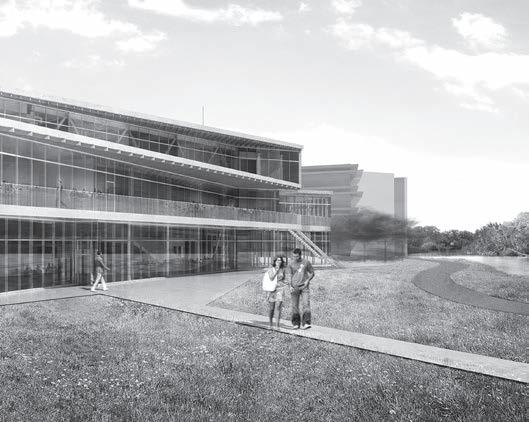
6 minute read
Canadian Cities: Taxes
CANADIAN CITIES: CONFRONTING A CHALLENGE
Taxing service users generates revenue and shows potential to change behaviour
HARRY KITCHEN, professor emeritus, Economics
Never have Canada’s largest cities faced so much uncertainty when it comes to their future fiscal sustainability. Changing demographics, increased income inequality, the impact of climate change and federal immigration policies, growing social service needs, and deteriorating infrastructure will push municipal expenditure needs well beyond anything experienced in the recent past. When this is combined with a revenue base that is largely controlled by provincial legislation and has remained virtually unchanged for decades (user fees and property taxes being the mainstay), concerns over fiscal sustainability are becoming a major issue. One remedy to remove this increasing gap and one that is gaining traction among many city officials, if not the public at large, is the importance of introducing legislation that would permit cities to expand their local tax base. This action would bring Canadian cities in line with many large US and European counterparts.
At the outset, it should be noted that advocating for new taxes is not to diminish the importance of the property tax. The property tax has been around for decades. It is a good tax for municipal governments because it satisfies many characteristics of a fiscally sound local tax. Property is immovable so it cannot escape the tax, it is fair based on the benefits received from local government services, and revenues are stable and predictable. Nevertheless, it is relatively inelastic (does not grow automatically as the economy grows), highly visible, and politically contentious almost everywhere. This high visibility and frequent opposition to increases in property tax rates means that spending on necessary services is always vulnerable to cutbacks and restrictions.
A mix of taxes would take pressure off the property tax and give cities more flexibility in responding to local conditions such as changes in the economy, evolving demographics and expenditure needs, changes in the political climate, and other factors. Cities would be in a better position to achieve revenue growth, revenue stability, and fairness in the tax impact on local residents. Lower property taxes would greatly assist those who are asset rich (high property values) but income poor, an outcome that would make it easier for some people to remain in their homes without the heavy burden of high property taxes.
Which new tax or taxes? There are a number that could be used (of course, the province would have to permit municipalities to adopt a new tax which in itself is likely to be an impediment, at least in the short run). Some taxes would be easier to implement and likely more politically acceptable, especially if the tax is on the user of the service with revenues earmarked for that service. Taxes of this sort achieve two objectives—one, the capacity to generate revenue and two, the potential to change behaviour so that local resources are not wasted or squandered. Perhaps the following example best illustrates this.
In most large cities, roads and transportation absorb between 20% and 30% of all property tax revenue. This is a service whose funding could be removed from the property tax base. In its place, it could be funded from road prices or road charges (sometimes called congestion prices). Efficient road prices offer a number of advantages. They are widely recognized as an effective travel demand management tool for reducing congestion, pollution, and other external costs of driving. They can influence all dimensions of travel choice: trip frequency, destination,
travel mode, time of day or week, route, and so on. To the extent that traffic demand is managed, cost pressures on a city’s budget are lowered, because traffic-related costs are reduced and infrastructure demands lessened. Furthermore, if revenues are dedicated to public transit and roads, there is almost certain to be more public acceptance for funding the service than if it were funded from general revenues. Other charges that could be used to finance roads and that are used in some countries include a municipal gas tax, a municipal motor vehicle registration fee, and dynamic parking fees that vary by time of day and location, but these are likely to be less effective in changing behaviour and generating revenue.

Shutterstock © Light Poet

Other taxes that are strong candidates for large cities include a municipal income tax and/or a municipal sales tax. Unlike road pricing, these taxes are not on users of a specific service. Instead, they are on income earned or money spent with revenues going into general funds, just like the property tax revenue. They have the potential to generate significant sums of revenue and are preferred to property taxes as a funding source for local services that are primarily income redistributional in nature, such as social housing and social services. These taxes are easy to administer as long as they are piggybacked onto existing provincial taxes. As well, they are less regressive than the property tax in their impact on taxpayers. They would permit cities to capture revenue from commuters and visitors who are the beneficiaries of many local services but do not currently pay for them because they are funded by the property tax. It would also give cities greater flexibility and breadth in determining their own tax structure and allow them to benefit from growth in the economy. For any new tax, however, it is critical that the locally elected council be responsible for setting the local tax rate. This, the literature tells us, leads to greater accountability, enhanced transparency, and improved decision making in the ways in which municipalities spend their money.
One concern with any new tax, it must be noted, is its cross-border impact. Higher tax rates in one city could lead to jobs relocating to neighbouring jurisdictions, people moving to a lower tax area, and people shopping in neighboring municipalities. The best way to minimize this problem, as the empirical literature has concluded, is to implement these taxes in large cities and large metropolitan and regional areas, making it more unattractive and costly for individuals to initiate an activity intended to avoid the tax. These taxes are unlikely to be appropriate for small and medium-sized municipalities where residents and businesses can easily cross municipal borders to relocate, do their shopping or search for work. For these municipalities, they may have to stick with the traditional revenue tools plus some provincial grant assistance for fiscally distressed areas.

Harry Kitchen is Professor Emeritus in the Economics Department at Trent University. Over the past 30 years, he has completed more than 100 articles, reports, studies, and books on a range of issues relating to local government expenditures, finance and governance in Canada and abroad.
UNLEASH THE POTENTIAL
DONORS UNLEASH THE STUDENT CENTRE
ANNOUNCING… THE NEWEST MEMBERS OF OUR
PRESIDENT’S CIRCLE
Ken Hartwick ’81 Gavin Marshall ’76 Greg Piasetzki ’72 Don Tapscott ’66 & Ana P. Lopes Martha Wilder ’74
E.W. Bickle Foundation
Thank you for your generous support of the new Student Centre, opening Fall of 2017.
There is still time to support the Student Centre.
The President’s Circle recognizes donors who have made contributions of between $100,000 to $249,999.










